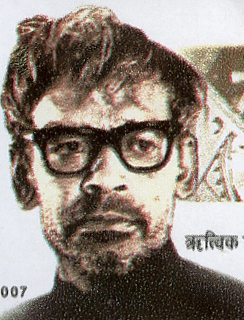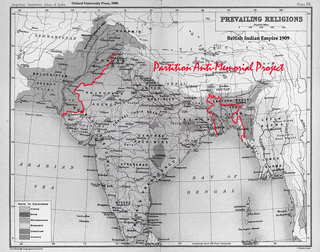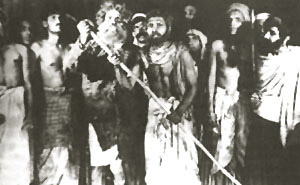
Bengali music comprises a long tradition of religious and secular song-writing over a period of almost a millennium. Composed with lyrics in the Bengali language, Bengali music spans a wide variety of styles.

Ritwik Kumar Ghatak was a noted Indian film director, screenwriter, actor and playwright. Along with prominent contemporary Bengali filmmakers like Satyajit Ray, Tapan Sinha and Mrinal Sen, his cinema is primarily remembered for its meticulous depiction of social reality, partition and feminism. He won the National Film Award's Rajat Kamal Award for Best Story in 1974 for his Jukti Takko Aar Gappo and Best Director's Award from Bangladesh Cine Journalist's Association for Titash Ekti Nadir Naam. The Government of India honoured him with the Padma Shri for Arts in 1970.

Meghe Dhaka Tara is a 1960 film written and directed by Ritwik Ghatak, based on a social novel by Shaktipada Rajguru with the same title. It stars Supriya Choudhury, Anil Chatterjee, Gita Dey, Bijon Bhattacharya, Niranjan Roy, and Gyanesh Mukherjee. It was part of a trilogy consisting of Meghe Dhaka Tara (1960), Komal Gandhar (1961), and Subarnarekha (1962), all dealing with the aftermath of the Partition of Bengal during the Partition of India in 1947 and the refugees coping with it.

Madhabi Chakraborty is an Indian actress. She won the National Film Award for Best Actress for her performance in the Bengali film Dibratrir Kabya. She has acted in some of the most critically acclaimed films in Bengali cinema and is considered one of the great actresses of Bengali cinema.

The Partition of Bengal in 1947, also known as the Second Partition of Bengal, part of the Partition of India, divided the British Indian Bengal Province along the Radcliffe Line between the Dominion of India and the Dominion of Pakistan. The Bengali Hindu-majority West Bengal became a state of India, and the Bengali Muslim-majority East Bengal became a province of Pakistan.

The Partition of India and the associated bloody riots inspired many creative minds in the republics of India, Pakistan, and Bangladesh to create literary/cinematic depictions of this event. While some creations depicted the massacres during the refugee migration, others concentrated on the aftermath of the partition in terms of difficulties faced by the refugees in both side of the border. Even now, more than 60 years after the partition, works of fiction and films are made that relate to the events of partition. W.H. Auden in his poem "Partition" showed the dilemmas of Cyril John Radcliffe, 1st Viscount Radcliffe, responsible for deciding which parts of India went where.

Bengali theatre primarily refers to theatre performed in the Bengali language. Bengali theatre is produced mainly in West Bengal, and in Bangladesh. The term may also refer to some Hindi theatres which are accepted by the Bengali people.

Jukti Takko Aar Gappo is a 1974 Bengali film directed by auteur of Indian cinema Ritwik Ghatak. Jukti Takko Aar Gappo was Ritwik Ghatak's last film. The film was believed to have a cinematography way ahead of its time. The film won National Film Award's Rajat Kamal Award for Best Story in 1974.

Nagarik, also spelled as Nagorik, was the first feature-length film directed by legendary Indian director Ritwik Ghatak. Completed in 1952, it preceded Satyajit Ray's Pather Panchali as perhaps the first example of an art film in Bengali cinema, but is deprived of that honor, since it was released twenty-four years later, after Ghatak's death. On 20 September 1977, it finally premiered at the New Empire theatre in Kolkata, India. Ghatak directed only eight feature films, but is generally regarded as one of the auteurs of Indian cinema and virtually unsurpassed as a creator of powerful imagery and epic style by directors such as Satyajit Ray and of transcendental power and extraordinariness by critics such as Derek Malcolm.

Subarnarekha is an Indian Bengali film directed by Ritwik Ghatak. It was produced in 1962 but not released until 1965. It is a part of the trilogy that includes Meghe Dhaka Tara (1960), Komal Gandhar (1961) and Subarnarekha (1962), all dealing with the aftermath of the Partition of India in 1947 and the refugees coping with it.

The Noakhali riots were a series of semi-organized massacres, rapes and abductions, combined with looting and arson of Hindu properties, perpetrated by the Muslim community in the districts of Noakhali in the Chittagong Division of Bengal in October–November 1946, a year before India's independence from British rule.

Cinema of West Bengal, also known as Tollywood or Bengali cinema, is an Indian film industry of Bengali-language motion pictures. It is based in the Tollygunge region of Kolkata, West Bengal, India. The origins of the nickname Tollywood, a portmanteau of the words Tollygunge and Hollywood, dates back to 1932. It was a historically important film industry, at one time the centre of Indian film production. The Bengali film industry is known for producing many of Indian cinema's most critically acclaimed global Parallel Cinema and art films, with several of its filmmakers gaining prominence at the Indian National Film Awards as well as international acclaim.

Abhi Bhattacharya was an Indian actor of Hindi and Bengali cinema, who is most remembered for his roles in films of the 1950s and the 1960s, such as Yatrik (1952), Jagriti (1954), Anuradha (1960), Subarnarekha (1965) and Amanush 1975. In his four decade long acting career he performed in more than 150 films in Hindi and 21 in Bengali. Abhi Bhattacharya worked with eminent film directors of India such as Ritwik Ghatak, Guru Dutt, Bimal Roy and Satyen Bose.

Bari Theke Paliye is a 1959 coming-of-age Bengali film by director Ritwik Ghatak.

The 1964 East Pakistan riots refer to the massacre and ethnic cleansing of Bengali Hindus from East Pakistan in the wake of an alleged theft of what was believed to be the Prophet's hair from the Hazratbal shrine in Jammu and Kashmir in India. The salient feature of the pogroms was its urban nature and selective targeting of Bengali Hindu owned industries and merchant establishments in the capital city of Dhaka. This resulted in unending waves of Bengali Hindu refugees in neighbouring West Bengal. The refugee rehabilitation became a national problem in India, and hundreds of refugees were resettled in Dandakaranya region of Odisha & Madhya Pradesh.

The 1950 East Pakistan riots took place between Hindus and Muslims in East Pakistan, which resulted in several thousands of Hindus being killed in pogroms.
Nemai Ghosh, or Nimai Ghosh (1914–1988), was an Indian film director and cinematographer, best known for his film Chinnamul (1950).
Nabyendu Chatterjee was an Indian Bengali and Hindi film director and producer. A director of twelve feature films and three documentaries, Nabyendu has curved out a sure niche for him in the field of serious and useful cinema of India.
















